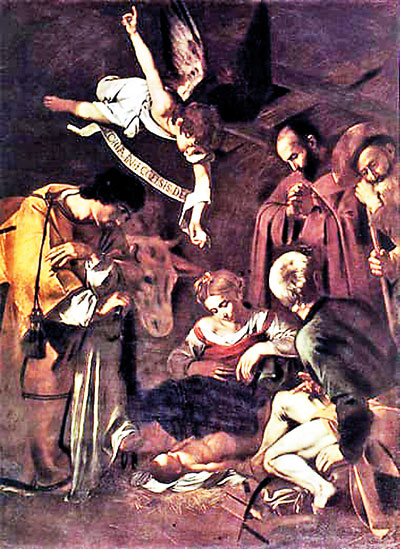Sunday Times 2
Theft of Caravaggio in Sicily still shrouded in mystery 50 years on
View(s):
Carvaggio's Nativity
Antonella Lampone will never forget that night. Thunder and lightning shook the skies as thick and grey clouds seemed to give back to Sicily all the water it had not received that entire summer.
A few metres from her small apartment in the Oratory of Saint Lawrence in Palermo, where her mother was a housekeeper, one of the most notorious art thefts in history was taking place, as a Caravaggio that had hung for more than three centuries above the altar was cut out of its frame.
Fifty years have passed since 17 October 1969, but Michelangelo Merisi da Caravaggio’s Nativity with St Francis and St Lawrence remains one of the world’s most sought-after works of stolen art.
Lampone was 15 at the time and living with her mother, Maria Gelfo, and her aunt in the church. “My mother and aunt were the first to arrive on the scene,” she said. “They were wailing and screaming.
“I fell out of my bed and ran to the altar of the church where the painting was hanging and that now was missing. We spent the next days mourning over that loss. They hadn’t stolen a painting; they had kidnapped a member of my family.”
Back then in Palermo, only one organisation had the power to steal such a treasure: the Sicilian mafia.
In a video interview filmed in 2001 but locked in a drawer and revealed last month exclusively to the Guardian, the parish priest of the oratory, Rocco Benedetto, said the painting was in the home of a powerful mafia boss who had sliced off a piece of the canvas in order to convince the Catholic church to come to the negotiating table for its return, contacting him twice by letter.
Lampone has confirmed Benedetto’s statements. “I recall that the parish priest told my mother that he had been contacted by the thieves to make a deal,” she said.
According to Benedetto, the painting was in the home of the mafia boss Gaetano Badalamenti, who at the time was one of the most powerful mobsters in Sicily, running a $1.65bn (£1.3bn) heroin trafficking network to the US.
Benedetto informed the police of the letters and the piece of canvas, but the files of his statements seem to have vanished.
A month ago, Sicilian investigators questioned Lampone. “I asked the police whether my mother’s formal statements were still in the police archives. She had been questioned dozens of times, but I was told that her files had disappeared,” she said.
Investigators are racing against time. Many suspects and witnesses of the crime are deceased, including Badalamenti, who died in 2004, and Benedetto, who died in 2013. Lampone’s mother passed away two years after the theft.
In the weeks preceding it, Lampone recalls her mother requesting greater security for a window in the church after several suspicious individuals had asked her to let them in so they could admire the painting.
“My mother was alerted, and she asked the Vatican Curia to secure a window in the oratory that was accessible from the street where the Caravaggio was displayed. But the Curia said that there was no need follow through,” she said.
It was precisely from that window that the thieves entered the church on a rainy night 50 years ago.
Hopes of solving the mystery behind the Nativity, the one and only painting signed by Caravaggio, were reignited in June last year after Italian investigators announced Gaetano Grado, a mafia informant, said Badalamenti had been put in touch with an art dealer in Switzerland.
Prosecutors are now looking to Switzerland, where new witnesses might hold the ultimate secret of one of the greatest mysteries in art history. The foremost question is whether the painting is in a good condition, even if the evidence strongly suggests otherwise.
In 1989, another mafia informant named Francesco “Mozzarella” Marino Mannoia revealed to the magistrate Giovanni Falcone that he had stolen the Caravaggio, rolling up the canvas to smuggle it out of the church. Lampone recalls a rug was also stolen that night, which was likely used by the thieves to roll up the canvas and protect it from the rain.
“That decision proved fatal,” said Maurizio Ortolan, a police officer who was present during Mannoia’s interrogation, since paint, hardened over centuries, easily cracks.
“Mannoia said that when they opened the canvas, the paint had partially disintegrated.”
Michele Cuppone, an expert on the missing Caravaggio, said: “Rolling up from the inside a canvas from the 1600s is one of the worst mistakes one can make.
“There have been other cases of stolen paintings that had been rolled up. When rediscovered, they were marred with deep horizontal cracks the entire length of the canvas.”
©The Guardian, UK

